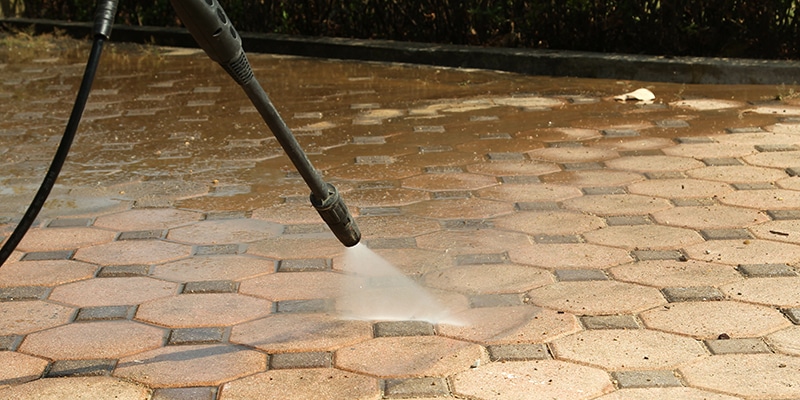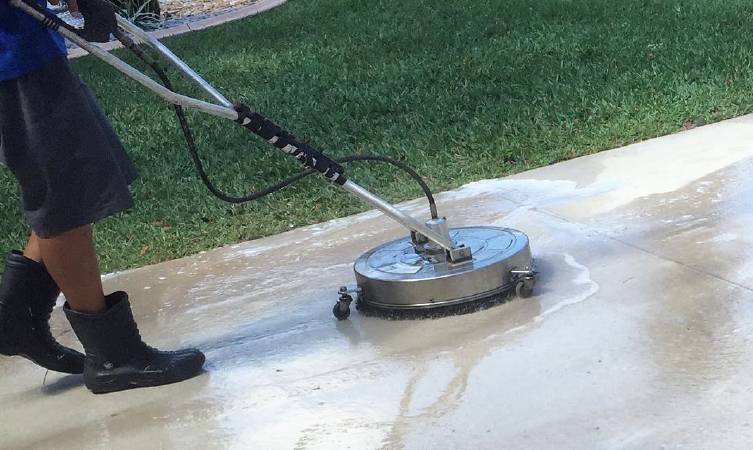High pressure cleaning uses pressurized water to remove dirt and grime from surfaces. This method cleans buildings, vehicles, and outdoor structures effectively.
High pressure cleaning, also known as power washing, revitalizes surfaces by blasting away accumulated dirt, mold, and other contaminants. It utilizes a high-pressure water spray, typically operated by a machine, which can be adjusted for different cleaning tasks. Homeowners and businesses often use this efficient process to maintain the appearance and longevity of their property.
The technique is particularly useful for tough-to-clean areas like driveways, sidewalks, decks, and patios, where stains and weathering can take a toll. With its ability to target various kinds of filth effectively, high pressure cleaning serves as a versatile solution for outdoor maintenance and cleaning challenges.
The Essence Of High Pressure Cleaning
High pressure cleaning unleashes the power of pressurized water to remove stubborn dirt, grime, and built-up residue from surfaces.
Unlike traditional cleaning methods, it uses less water and no harsh chemicals. Ideal for various cleaning tasks, this method is both effective and eco-friendly.
Core Principles Behind The Technique
The technique relies on high velocity water jets which penetrate and lift the grime from surfaces. It works based on two core principles:
- Mechanical force: Water strikes the surface with intense energy.
- Thermal effect: Warmer water can boost cleaning power.
Typical Applications And Settings
High pressure cleaning fits a range of environments:
- Residential exteriors like patios and driveways
- Commercial spaces such as parking lots
- Industrial settings for machinery cleaning
Each setting benefits from the unique advantages this method offers:
| Setting | Advantage |
|---|---|
| Residential | Boosts curb appeal, safe for homes |
| Commercial | Maintains cleanliness, attracts customers |
| Industrial | Enhances equipment lifespan, avoids downtime |

Credit: washh.com
Equipment And Tools Involved
Embarking on a deep clean journey outdoors? High-pressure cleaning might be the answer. This effective method uses advanced equipment and tools to remove dirt, grime, and stains. The right gear ensures clean, efficient, and safe results.
Types Of High Pressure Cleaners
Several types of high-pressure cleaners suit different needs:
- Electric Pressure Washers: Ideal for smaller, residential tasks.
- Gas Pressure Washers: Offer more power for larger areas.
- Hot Water Pressure Washers: Tackle greasy and oily surfaces.
- Cold Water Pressure Washers: Best for everyday dirt and mud.
Safety Gear And Accessories
Safety comes first. You’ll need:
- Safety Goggles: Protect your eyes from debris.
- Ear Protection: Reduce noise from the machine.
- Gloves: Grip machinery securely and protect hands.
- Boots: Wear non-slip boots for wet surfaces.
Other essential accessories:
| Accessory | Function |
|---|---|
| Nozzles | Adjust spray patterns and pressure. |
| Hose Extensions | Reach high or distant surfaces. |
| Brush Attachments | Scrub while spraying for deep clean. |
| Detergent Tanks | Apply cleaning agents efficiently. |
Comparing High Pressure Cleaning With Traditional Methods
When tackling dirt and grime, different cleaning methods serve various purposes. High pressure cleaning stands out for its powerful approach. Let’s dive into how it fares against traditional cleaning techniques under a couple of key aspects:
Efficiency In Removing Stubborn Stains
High pressure cleaning obliterates tough stains that regular cleaning can’t. This method uses forceful water jets to remove stains in one go. In contrast, traditional methods often require multiple attempts and considerable elbow grease. Here are some points showcasing the efficiency:
- Quick action on surfaces like concrete, brick, and stone
- No need for intensive scrubbing
- Effective against oil, grease, and mould
Water And Chemical Usage
High pressure cleaning is not only powerful but also sustainable. It reduces water consumption when compared with a hose or bucket washing. The table below compares water and chemical use:
| Cleaning Method | Water Usage | Chemical Usage |
|---|---|---|
| High Pressure | Less | Minimal |
| Traditional | More | Higher |
Environmental impact is lessened with high pressure cleaning due to minimal chemical agents. Conventional methods often rely on detergents that can harm nature and wildlife.

Credit: en.m.wikipedia.org
Diverse Uses Of High Pressure Cleaning
High pressure cleaning serves as a powerful tool across various settings. This versatile method uses water shot at high speeds to remove grime, dirt, and stubborn stains. It offers a sparkling clean without the harsh chemicals.
Residential Cleaning Projects
- Driveways and Garage Floors: Remove oil stains and tire marks.
- Deck Washing: Get rid of mildew and weather stains.
- Outdoor Furniture: Cleanse dust and bird droppings.
- Home Exteriors: Wash away dirt from siding and brickwork.
- Gutter Clearing: Unclog and clean gutters effortlessly.
- Pool Cleaning: Tackle water lines and build-up around pools.
Commercial And Industrial Applications
| Area | Benefits of High Pressure Cleaning |
|---|---|
| Parking Lots | Clean large spaces quickly and effectively. |
| Fleet Maintenance | Keep vehicles in top shape, boosting longevity. |
| Building Facades | Enhance curb appeal with a fresh look. |
| Manufacturing Floors | Remove oil, grease for a safer work environment. |
| Heavy Equipment | Prepare machinery for painting or new work tasks. |
High pressure cleaning is not just thorough but also eco-friendly and efficient. Whether tackling a greasy garage floor or sprucing up store fronts, the right pressure washer transforms a tough job into a quick, enjoyable task.
Do’s And Don’ts Of High Pressure Cleaning
High Pressure Cleaning uses water at high speed to clean surfaces. Think of it like a super-powerful hose. It lets you remove dirt, grime, and stains fast and well. But you should know the right steps and mistakes to avoid. Let’s learn how to do high pressure cleaning in the best way!
Best Practices For Effective Cleaning
- Check your equipment before starting. Make sure everything is in good shape.
- Choose the correct nozzle for the job.
- Test on a small area first. This helps you know the right pressure to use.
- Use steady, even strokes. Move from top to bottom to avoid streaks.
- Protect plants and outdoor items. Cover them up or move them away.
- Wear safety gear, like goggles and gloves. Stay safe while cleaning.
Common Mistakes To Avoid
| Mistake | Why to Avoid |
|---|---|
| Too much pressure | Can damage the surface, making it worse. |
| Wrong cleaning solution | May not clean well or could harm the surface. |
| Not wearing protective equipment | Safety is key. High-speed water can hurt you. |
| Cleaning in the wrong order | Start at the top to keep dirt from running onto clean areas. |
| Ignoring the weather | Wet conditions can affect cleaning and drying. |
Environmental Impact And Sustainability
High pressure cleaning, known for its effectiveness, also carries an environmental weight. Understanding its impact leads to sustainable practices. Let’s explore the eco-friendly side of this powerful cleaning method and the standards that guide it.
Eco-friendly Practices In High Pressure Cleaning
Eco-friendly practices are key in reducing the environmental footprint of high pressure cleaning. Here are ways this is achieved:
- Water Conservation: High-efficiency nozzles reduce water usage.
- Biodegradable Cleaners: Chemicals break down naturally, limiting harm.
- Heat over Chemicals: Hot water pressure cleaning minimizes chemical needs.
- Recycling Water: On-site water treatment allows reuse and decreases waste.
- Energy Efficiency: Electric models can offer cleaner energy consumption.
Regulations And Standards
Specific regulations and standards ensure high pressure cleaning remains eco-conscious. Here’s a snapshot:
| Regulatory Body | Standards or Regulations |
|---|---|
| Environmental Protection Agency (EPA) | Guidelines on wastewater management and safe chemical use |
| Occupational Safety and Health Administration (OSHA) | Safety protocols for operating pressure cleaning equipment |
| Local Governments | Restrictions on water usage and runoff control |
Professionals adhere to these regulations and standards to protect our planet. Compliance ensures the longevity and health of our ecosystems.

Credit: adpressurecleaning.com
Frequently Asked Questions On What Is High Pressure Cleaning?
What Is High Pressure Cleaning Used For?
High-pressure cleaning is used for removing stubborn grime, mold, dust, and loose paint from surfaces. It’s effective on driveways, decks, and house exteriors.
Can High Pressure Cleaning Damage Surfaces?
If not done correctly, high-pressure cleaning can damage surfaces. It’s crucial to use the right pressure settings and techniques for different materials.
How Often Should You High Pressure Clean?
The frequency of high-pressure cleaning depends on the location and type of surface. Typically, an annual or biannual clean is recommended for most residential spaces.
Is High Pressure Cleaning Eco-friendly?
High-pressure cleaning can be eco-friendly if it uses less water than traditional methods. Avoiding harsh chemicals also makes the process more environmentally friendly.
Conclusion
High pressure cleaning stands as a robust solution for tough grime. It’s efficient, cost-effective, and versatile for various surfaces. Ideal for homeowners and businesses alike, this method rejuvenates spaces with precision. Embracing this cleaning technique could dramatically enhance your maintenance routine.
Ready to blast away the dirt?
